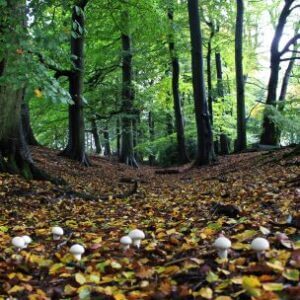
Preserving history
The Chilterns has been influenced by thousands of years of human activity, leaving traces that tell rich and historic stories.
The Chilterns Area of Outstanding Natural Beauty (AONB) is an ancient landscape with traces of bygone eras and previous settlers still visible today. The area is rich in Bronze Age barrows and field systems, Iron Age hillforts, medieval churches and deer enclosures, 18th-century sawpits, and 20th-century military trenches. Historic towns and villages stand out, with buildings and churches in characteristic flint, brick, and timber materials. While parish and private records, folk memory, and artefacts attest to the relatively recent lives, work, culture, customs, beliefs and politics of locals. All of these things create layers of evidence for human activity and settlement that provide a timeline for the evolution of the landscape and help define what is special about the Chilterns.

Taplow hillfort (c) CCB, by artist Mark Gridley
Our historic environment
The concept of the historic environment is wide ranging, encompassing all the physical manifestations of human activities from earliest prehistory to the present day. It includes buried archaeological remains, relict sites or ruins, historic buildings and villages, landscapes still in contemporary use, such as farms and field boundaries, industrial and military structures, ancient woodlands and commons, and country houses with their associated parks and gardens.
In the AONB there are:
- Listing Buildings: 47 Grade I; 2,2026 Grade II; 116 Grade II*; and 2 Grade II* at risk
- 94 Conservation Areas
- 113 Scheduled Monuments
- 8 Scheduled Monuments at risk
- 19 Registered Parks and Gardens (4% of the area of the AONB)
Image: Church of St Mary Magdalene, Flaunden, copyright Nigel Cox (Creative Commons Licence).

Many sites are still undesignated (recorded in local Historic Environment Records) or have yet to be found.
The natural and historic landscapes of the Chilterns have provided home and inspiration for some of Britain’s greatest artists and writers, including John Milton, Wilfred Owen, John and Paul Nash, Roald Dahl and Enid Blyton. At the same time, the nation’s politics have regularly been framed in the Chilterns, home to Prime Ministers including Edmund Burke and Benjamin Disraeli, and Chequers, the country house of the PM since 1921.
All this heritage is the basis for the Chilterns Conservation Board (CCB)’s understanding that the region is a living, breathing landscape, where people and nature are inextricably tied together. As such, our core work and flagship projects focus on the relationships and links between the landscape and human life. At local and county levels, we are working to record, conserve and enhance the historic environment of the Chilterns, helping people to understand and enjoy it, while being mindful of how it impacts and enriches the natural landscape around it.
To find out more about our pastimes and how we preserve the character and cultural aspects of our landscapes, visit our history and heritage section.
Threats to our history and heritage
The Chilterns AONB faces significant threats to its historic environment. Archaeology is a finite asset, and many sites in the Chilterns are highly sensitive, surviving only as subtle earthworks or fragile deposits. Unfortunately, the AONB faces a future of unprecedented demands for development in housing and infrastructure, directly impacting the archaeology beneath our feet and the landscapes surrounding us. Numerous undesignated or unknown sites are at even greater risk, lacking statutory protections.
Development pressures:

Mushrooms in Grim’s Ditch
Developments can lead to the destruction of sites of national importance and the alteration of the character, cultural heritage and spirit of the Chilterns AONB. For example, the construction of HS2 will erase a section of Grim’s Ditch, a Scheduled Monument. Unsympathetic design choices, inappropriate locations for development, unsuitable materials, and lack of knowledge and time in the planning process are all risks to the historic environment of the Chilterns.
Changes in land management:
The decline of traditional agriculture and industry has led to changes in land and woodland management, and the funding given to farmers for protecting heritage assets is uncertain.
Sites and landscapes left unprotected:
While designated assets, such as Listed Buildings, Registered Parks and Gardens, and Scheduled Monuments are protected, their wider setting, which is often integral to their character, is not. The approach to designation takes a site-specific, rather than landscape-scale, approach. Also, the majority of known archaeological sites are ‘undesignated heritage assets’, so lack any statutory protection at all.
The condition of the Chilterns’ designated assets (Listed Buildings, Registered Parks and Gardens, and Scheduled Monuments) has remained largely stable in the recent past. This is due to statutory protections and proactive management from owners. Only two Listed Buildings are designated ‘At Risk’ by Historic England, along with eight Scheduled Monuments.
Lack of understanding and engagement:
The heritage of the Chilterns is less well recognised and understood than other protected landscapes, making its protection and presentation much more difficult. Limited resources are also a problem for many agencies involved in tourism and heritage promotion.
Historic assets are an irreplaceable resource. They deliver wide social, economic, cultural and environmental benefits, so careful management is needed. Through landscape-scale approaches to planning, land use and development, and through collaboration and coordination between partners, we can preserve the rich legacy of the past for the benefit of future generations.

Ensuring a future for our past
A ‘voice for archaeology’ in the Chilterns AONB, ensuring that the millennia-long story of the region is shared with the millions who live in and visit.
The Chilterns Heritage and Archaeology Partnership (CHAP) is an exciting new initiative being launched by the CCB this November. CHAP will be a driving force in the conservation and sustainable management of archaeological assets in the Chilterns, working in partnership with organisations and communities throughout the region for lasting, positive change. The story of our interconnectedness with nature will be shared, and opportunities for diverse Chilterns’ communities to participate in the discovery of the past will be created. We aim to better understand the present, and plan for the future.




